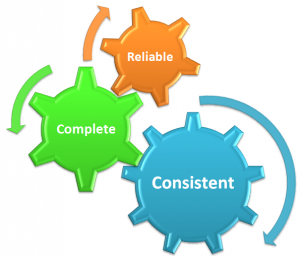In an ideal world your data should be Reliable, Complete and Consistent but reality often shows that it is not.
Reliability – your ability to base your business decision on your data
 Every day we make decision based on the information our solutions hold about our clients and leads, whether these decisions are simple auto-replies to enquiries on a website, advanced workflow rules which shall guide the lead to a purchase, or a human based decision based on a client support request.
Every day we make decision based on the information our solutions hold about our clients and leads, whether these decisions are simple auto-replies to enquiries on a website, advanced workflow rules which shall guide the lead to a purchase, or a human based decision based on a client support request.
These decisions are often based on numbers, events and historical data, but if this is not up to date, if the data is not consolidated, the numbers a not correct and we do not have a full history of the events in the past which has lead to this new situation where a decision has to be made.
Reliability not only gives predictability on reporting, forecasts, campaign outcomes, it also drives user adoption and trust which all encourages more usage, leadership and progress and the willingness to taking initiative, go beyond.
Completeness – your ability to engage in a multi-channel, conversational communication
Completeness is to have a variety of information which can be used to make your communication engaging, relevant and conversational.
Data enter into your database from multiple sources, and the data often enter with different levels of completeness and accuracy. Website registrations often provide limited amount of information (except for the email provided), while your order intake process also include the billing address details.
So one thing is to have an email for your outbound email communication, but phone/SMS, physical address, Geo-location, historical activities, purchases, interests etc are all elements which are needed in order to personalize the communication.
In many database (which we have come across over the last 12 years) we often see that for important fields like email, geographic location, industry and other segmentation fields like job role etc. the empty fields are often the most common field value.
Completeness or the lack of it should result in 2 initiatives:
- Implementation of processes which can consolidate the data and enrich the records from multiple sources, eventually combined with a data enrichment process.
- An exclusion of records with lacking information in the reports and decision making processes (workflows), eventually with an exception handling process for these data sets.
Consistency – your ability to get what you expect from your data
Consistency the ability to compare data, segment, filter and categorize. We can all relate to a number: is 1M in revenue good or bad? Well it depends on what the number was last time, so without consistency you will not be able to compare apples against apples.
While thinking about optimal completeness your data fields may be populated, but a simple report to extract leads from the UK, may be difficult when the country field is populated with: UK, England, United Kingdom, Scotland etc.
You could of cause implement validation processes on your data prior to importing it, but you cannot always force a data validation process on all your data entry points, it will as an example most likely prevent a lot of web registrations from being submitted, and note that even pick-list fields in salesforce can be loaded with values not complying to the pick list values if data is imported from data loading application, the APIs or other integrations.
You should therefore also consider implementing a process where you regularly or after the record creation (regardless of source) scan your records, and make sure that you identify gaps and inconsistencies, so that you can apply correctional actions on the bad records.
How to know which data is reliable?
To get reliable data for your business decisions heavily relies on the completeness and consistency of your data. If one of these 2 elements isn’t present, your data will not be reliable, and you should exclude the un-reliable data from your decision making process.
With a philosophy of not being a tool which only can be used to fix things when they are broken, the DataTrim Data Laundry concept is a suite of solutions and services which also include collection of data quality metrics which can be used in reports and dashboard in salesforce for you to decide where you want to focus your data cleaning efforts, and which of your existing data you can trust.
Contact Us for more information
DataTrim helps companies and organizations worldwide in improving and maintaining a high level of Data Quality.
DataTrim improve the reliability completeness and consistency by applying a set of data cleaning treatments which is called The Data Laundry.
The Data Laundry solutions and services adds experience based data cleaning processes to lead management, marketing automation, customer support and account management processes in salesforce and created direct impact on the day-to-day usage and productivity in a simple-to-use, collaborative and cost effective way.
